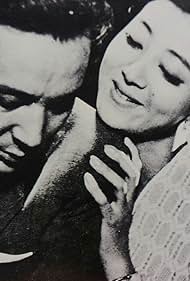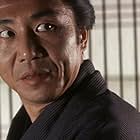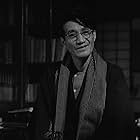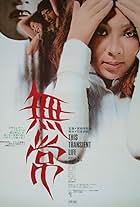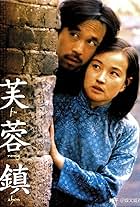By 1964, Kô Nakahira had been tossing between genres and with this film he slowly began to return to his roots in order to make more auteur films that he was known for 'taiyozoku' (sun tribe) subgenre of films dealing with post-war japan youths. It was based on the novels of Shintaro Ishihara who passed away earlier this year in the month February. His film are cited as precursor to the Japanese New Wave and way ahead than the Nouvelle Vague. Crazed fruit is still one of the key films in the career of Nakahira.
Coming to, Flora on the Sand (Suna no Ue no Shokubutsu-gun), this was adapted from Junnosuke Yoshiyuki's novel and deals with cosmetic salesman Ichiro Igi (Noboru Nakaya) who has an unresolved conflict and existential crisis. The film opens with Paul Klee's painting as Nakahira questions the viewer, he narrates what happens if a dash of red would take over the painting as the color keeps appearing in the runtime. The script of the film is an incredible interweaving storylines, surrealism to explore the psyche of the characters. The protagonist has doubts if his deceased father had slept with his wife when she was young, this haunts him, even the barber tell him the incident is true. He gets acquainted with teenage girl Akiko (Mieko Nishio) and deflowers her. After sleeping with him, she speaks her mind and wants Igi to take revenge on her older sister Kyoko (Kazuko Inano), a bar hostess with a kink for masochistic sex. In the course of this strange psychosexual fever-dream, all the threads lead to more fantasies, mysteries revealing oedipal complex and incest. Things aren't clear as there is ambiguous scenes and all this looks very aesthetically hypnotic and stylish. The finale scene ends as Igi is holding Kyoto, looking straight in her eyes and kisses the rope scars. The carnal pleasures here takes a psychosexual turn, Nakahira uses it to tickle the psyche. He positions his characters in the right corner of elevator, in the background the the floor is empty, there's emptiness inside, the inability to clearly perceive the surrounding reality. The fabulousness of the cinematography is a plus, it is frighteningly gloomy. My favourite is the two minute static shot of three black faces with spectacles and no light, just a close up shrouded in a haze of darkness and vice.
Sadly, this didn't go well with Nikkatsu and after few years, Ko Nakahira (under the pseudonym of Yang Shu-Hsi) would find a place in Hong Kong remaking his own films which was produced by the Shaw Brothers. However, Nikkatsu launched "Roman Porno" films in 1971, Toei followed in 1972. I know Yasuzo Masumura, Keisuke Kinoshita and Nagisa Oshima are hugely credited for inspiring filmmakers and a new generation that would be later dubbed the Japanese New Wave. But i want to mention that Ko Nakahira's contribution is immense for shaping the Roman Porno and the Japanese New Wave.
In "Flora of the Sand" we see the Protagonist's affair between two girls: a lover with a ploy and her sister, complicated by a surreal excursion into his past trauma, obsession. I even recommend Yasuzô Masumura's Kôshoku ichidai otoko (1961) as a double bill.
